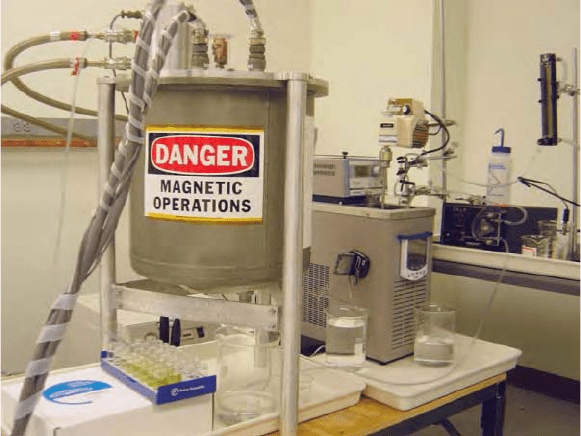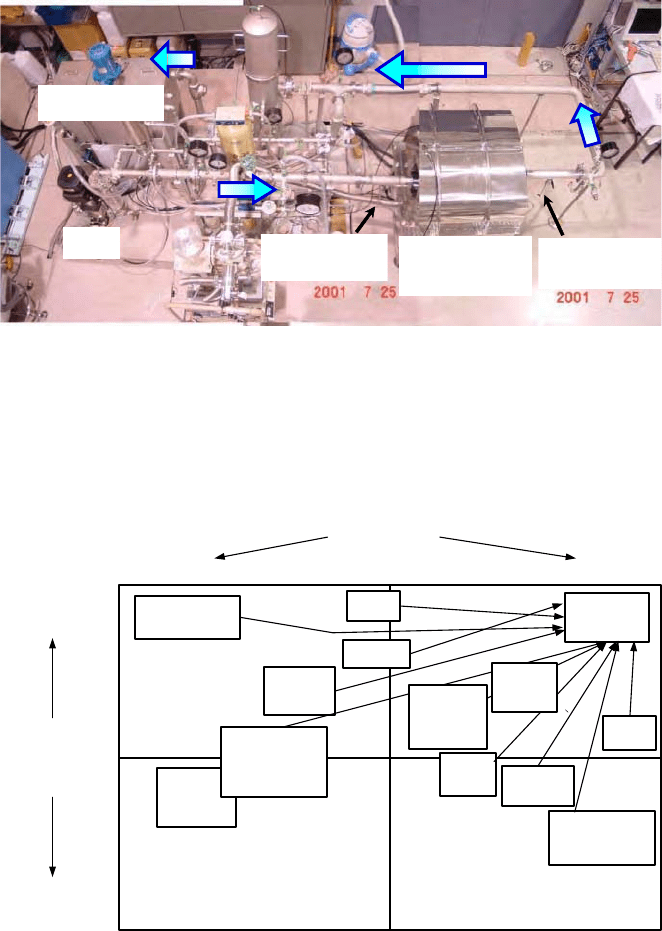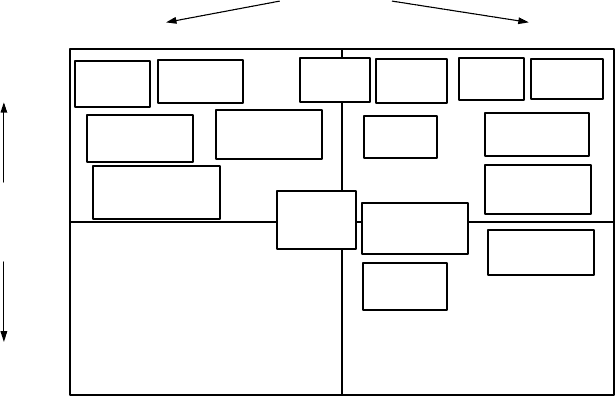Jan Svoboda. Magnetic Techniques for the Treatment of Materials
Подождите немного. Документ загружается.

570 CHAPTER 7. INNOVATION AND FUTURE TRENDS
production of biomaterials, such as antibodies, magnetic support technology
has potential for large-scale and continuous separation in biological, mineral,
e"uent and soil cleaning processes.
The combination of magnetic support technology and processing by magnetic
means may ultimately result in a technique which will not only compete with
conventional separation techniques, but may also stimulate a radical change in
overall plant design [M40].
Magnetic fluids
The use of magnetic fluids is attractive for separation of dense materials. Fer-
rofluids exposed to a non-homogeneous magnetic field acquire an apparent den-
sity exceeding densities obtained by conventional density-based methods. Fer-
rohydrostatic separation of copper, zinc, lead and precious metals is feasible
on a production scale. The development of cost-eective, environmentally and
user-friendly ferrofluids that can be easily recycled will enhance even further the
significant potential of FHS.
A major contribution to the applicability of FHS on industrial scale would
be the development of ferrofluids with high saturation polarization. Such fluids,
with saturation polarization in the range from 0.1 T to 0.2 T have been pre-
pared using particles of iron nitride or other ferromagnetic elements and alloys.
However, the fluids lack stability in contact with the atmosphere. Eorts are
under way to coat or otherwise protect the particle surfaces and enhance their
usefulness [R30].
Present day magnetic fluids are black in colour. Clear or lightly coloured
fluids would permit better visual control of the separation process. Recent ad-
vances in organic magnetic materials oer a hope in this line of investigation.
When magnets based on room-temperature superconductors become avail-
able, it will be possible to generate high magnetic fields at low cost and weakly
magnetic fluids can replace the present-day ferrofluids. For instance, solutions
of paramagnetic salts, because of their molecular make-up, are not appreciably
subject to the inhomogeneities that can develop in sub-colloidal ferrofluids ex-
posed to high gradient magnetic fields [R30]. Accuracy of density separation
will thus be increased.
7.5.4 Prospects for superconductivity in magnetic separa-
tion
Superconducting magnetic separation has made a number of important techni-
cal advances in the last twenty years, The first large superconducting separator
has been operating successfully in the USA since 1986 and a larger system, with
twice the capacity, was installed in 1989. A novel design of a superconducting
separator with a reciprocating canister system was installed and successfully
operated for clay processing in 1989. Following this, a number of other cyclic
and reciprocating separators have been installed for kaolin processing in various
7.5. WHAT THE FUTURE HOLDS? 571
parts of the world. Furthermore, there appears to be an opportunity to retro-
fit superconducting coils into conventional high-gradient magnetic separators
[W36].
High-temperature superconductivity in magnetic separation
The discovery of high-temperature superconductors (HTS) in 1986 stimulated an
enormous research eort into such materials. The discovery of the Y-Ba-Cu-O
(YBCO) compounds with a superconducting transition temperature W
f
as high
as 92 K created a real possibility of practical devices operating in liquid nitrogen
at 77 K. Such a development would imply that the capital and running costs,
associated with the production and maintenance of the necessary conditions to
operate these devices, would be considerably reduced, perhaps by as much as a
factor of 10 [W37].
At present, and for the foreseeable future, high-T
f
superconducting wires
or tapes cannot compete economically and technically with low-T
f
supercon-
ducting materials, as they are too expensive and the current density they can
deliver is too small [W38, B50]. The limitation arises from the sensitivity of the
high-T
f
materials to their own magnetic field.
This situation will remain until there is a technical breakthrough in the
processing and production of high-T
f
materials in wire or tape form [W38].
Moreover, there are only limited economic advantages in using wire-wound
high-T
f
superconducting devices compared to low-temperature superconduct-
ing magnets. The wire-wound device will be of approximately the same cost as
alow-T
f
device. Since the cost of a large wire-wound superconducting system
is usually dominated by the winding, which is 70% to 80% of the total cost, the
saving will only be in the cryogenic areas [W37].
There is, however, a possibility of trapping the magnetic field in hollow tubes
of a superconductor or in solid discs, without the necessity of winding a coil.
Flux tubes are similar to solenoid permanent magnets and have a field trapped
inside the tube. The field is produced by supercurrents flowing in the walls of
the tube [W39, W40]. The system runs in the persistent mode. As the field
in the flux tube decreases with time, due to flux creep, the field is topped up
using a flux pump. Such a device is schematically shown in Fig. 7.13. The
flux can be introduced into a pump through a flux gate 1, which is a region
of a superconductor which can be switched thermally so that it can act in two
modes. In these modes the flux gate can either prevent or allow the passage of
magnetic flux. The flux introduced into the pump can be compressed with a
mandrel and then it passes through flux gate 2 into the working region. This
process can continue indefinitely.
This approach could provide the cheapest option for magnetic separation on
a large scale [W41]. It has been estimated [W37] that the cost of manufacturing
flux tubes, if it can be done by standard ceramics processing, could be reduced by
a factor of 20 compared to an equivalent wire-wound solenoid. By including the
cost reduction by the factor of 10 by operating the magnet at liquid nitrogen
temperature, the economics of such devices would be improved significantly.

572 CHAPTER 7. INNOVATION AND FUTURE TRENDS
Working
volume
Pump volume
Superconducting
mandrel
Gate 2 Gate 1
Flux tube
Figure 7.13: Flux tube with flux pump and superconducting mandrel (adapted
from Watson [W38]).
And the likelihood of producing, in a short time, a high-T
f
superconductor
with high critical current M
f
,ofatleast5×10
2
A/mm
2
at 77 K, is much better
than for a wire-wound solenoid [W38].
As yet, no flux tubes with flux pumps have been constructed from high-T
f
material, but it appears to be potentially a rewarding direction of investigation
that might lead to a breakthrough technology.
At the same time, in several recent projects, high-T
f
superconducting coils
have been used in small-scale magnetic separators. A collaboration between
the Los Alamos National Laboratory and American Superconductor Corp. pro-
duced a small HTS magnetic separator with outer diameter of the magnet of
180 mm, inner diameter of 50 mm and height of 155 mm [D22]. The magnet,
shown in Fig. 7.14, is made of 624 m of Ag/BSCCO superconducting wire and
uses a pair of HTS current leads that are designed to operate with the warm
ends at 75 K and the cold ends at 27 K. The system operates in vacuum and is
cooled by a two-stage Giord-McMahon cryocooler. The upper stage of the cry-
ocooler cools the thermal shield and two heat pipe thermal intercepts attached
to the current leads. The lower stage of the cryocooler cools the HTS magnet
and the lower end of the HTS current leads. At 40 K the magnet can generate
a magnetic induction of 2 T in 25 mm warm bore, at a current of 120 A .
A joint project between Aquafine Corp., Sumitomo Electric and Du Pont
yielded an HTS magnet of dimensions similar to those of the LANL/ASC system
[I7]. The magnet generated a maximum magnetic field of 4 T at 4.2 K, 3 T at
21 K and 0.65 T at 77 K. In the tests, the magnet was operated at 20 K,
generating 2.5 T in 38 mm warm bore, and was cooled by a two-stage Giord-
McMahon cryocooler. The separator was applied to kaolin beneficiation and it

7.6. RESEARCH AND DEVELOPMENT NEEDS 573
Figure 7.14: The LANL/American Superconductor Corp. high-temperature su-
perconducting magnet for magnetic separation (courtesy of Los
Alamos National Laboratory).
was observed that although an increase in the magnetic field from 2 T to 2.5 T
did not produce any significant improvement in the quality of the concentrate,
a higher throughput was achieved, without loss of quality.
An HTS magnetic separator built jointly by the University of Tsukuba,
Iwate Industrial Promotion Centre and National Institute for Materials Science,
Japan, has been applied to the removal of endocrine disrupting chemicals from
waste water [M45]. The magnet generates a magnetic induction of 1.7 T in 200
mm inner bore. A photograph of the experimental set-up is shown in Fig. 7.15.
7.6 Research and development needs in mag-
netic separation
The current research and development initiatives and needs are shown in Fig.
7.16. Several important trends can be identified. As a result of these trends and
drives, several magnetic techniques are likely to move, in the foreseeable future,
into Pasteur’s quadrant and become available for industrial applications.
Magnetic separation methods that have been, to a greater extent, conceived
empirically and applied in practice, such as superconducting magnetic separa-
tion, HIMS, small-particle ECS and biomedical separation, are being studied
from a more fundamental point of view and further progress can be expected in

574 CHAPTER 7. INNOVATION AND FUTURE TRENDS
Figure 7.15: The Tsukuba/Iwate/NIMS (Japan) HTS magnetic separator for
treatment of waste water.
Consider at ion for use ?/
Appr oach
Blue skies Practical
Quest for
under -
st anding?
Knowledge of
fundamentals
Empirical
heuristic
Future
magnetic
separation
OGMS
FHS
Fine
particle
ECS
WHIMS
New
magnetism-
based
techniques
Small
particle
ECS
Biomedical
MS
Flocculation
of weakly
magnetic
materials
High-temperature
superconductivity
Magnetic flotation
Magnetic cyclone
Magnetic gravity
Magnetic
comminution
Magnetically-
controlled
fluidized bed
Magnetic
tagging
Figure 7.16: The current trends in the development of magnetic separation tech-
niques (adapted from Svoboda [S97]).
Water reservoir
Pump
Bi-2223
superconducting
magnet
Sampling valve
(inlet)
Sampling valve
(outlet)

7.6. RESEARCH AND DEVELOPMENT NEEDS 575
Consider at ion for use ?/
Appr oach
Blue skies Practical
Quest for
under -
st anding?
Knowledge of
fundamentals
Empirical
heuristic
Fine
particle
ECS
New
magnetism-
based
techniques
Biomedical
MS
Flocculation of
weakly magnetic
materials
High-temperature
superconductivity
Magnetic flotation
Magnetic cyclone
Magnetic gravity
Magnetically-
controlled
fluidized bed
Magnetic
tagging
Novel
magnetic
fluids
Magnetic
classification
Magnetic
comminution
Magnetic
separation in
outer space
Biological and
medical effects of
magnetism
Magnetic
carriers
Conventional
magnetic
separation
New
magnetic
materials
Figure 7.17: The future research and development focus in the magnetism-based
methods of material treatment (adapted from Svoboda [S97]).
the near future.
On the other hand, methods such as fine-particle ECS, ferrohydrostatic sep-
aration, magnetic flocculation of weakly magnetic materials and magnetic tag-
ging, that have received attention on an academic level, are likely to enter the
development stage.
The application of high-temperature superconductivity to magnetic sepa-
ration and novel magnetism-based techniques are also being explored, either
theoretically, or empirically (magnetic flotation or gravity separation).
Of particular promise for rapid incorporation into wide-scale industrial use
are the following areas that are currently enjoying strong focus:
• An improved understanding of the theoretical and operational principles
of HGMS/WHIMS and possible resurrection of open-gradient magnetic
separation, based on correct assessment of the needs of the industry.
• The judicious and justified incorporation of low-temperature superconduc-
tivity into magnetism-based methods of materials handling.
• Further development of advanced permanent magnetic materials and their
incorporation into sophisticated magnet design.
To predict the future focus of research and development is a risky business;
nevertheless some well-defined trends can be identified. These trends allow the
576 CHAPTER 7. INNOVATION AND FUTURE TRENDS
author to venture a possible scheme of future developments. These conjectures
are illustrated in Fig. 7.17. The application of high-temperature superconduc-
tivity, magnetic flocculation of weakly magnetic materials, magnetic tagging
and carriers are likely to dominate the field of technological needs. It can also
be speculated that new magnetism-assisted techniques, such as magnetic grav-
ity separation, magnetic flotation, magnetic comminution and classification will
take advantage of having a much wider control over these processes as a result
of the presence of this additional external force.
However, for successful development and implementation of such novel meth-
ods of materials treatment, a research and development process that combines
vision, deep knowledge of scientific fundamentals, incentives and a clearly de-
fined action plan for a production environment, are essential.
List of Symbols
a radius of matrix element [m]
a
s
acceleration of particle [m/s
2
]
A Hamaker constant [J]
A cross-sectional area [m
2
]
A
f
cross-sectional area of cladding [m
2
]
A
p
cross-sectional area of magnet [m
2
]
A
s
cross-sectional area of particle [m
2
]
b radius of particle [m]
B magnetic flux density (magnetic induction) [T]
B
f
critical magnetic induction [T]
B
j
magnetic induction in air gap [T]
B
p
magnetic induction in magnet [T]
B
0
magnetic induction on surface of magnet [T]
B
s
magnetic induction for flocculation into primary minimum [T]
B
u
remanent magnetic induction [T]
B
v
magnetic induction for flocculation into secondary minimum
[T]
BH energy product [J/m
3
]
(BH)
l
intrinsic energy product [J/m
3
]
(BH)
max
maximum energy product [J/m
3
]
c concentration of particles [m
3
]
c
lq
influent concentration [m
3
]
c
rxw
e"uent concentration [m
3
]
c
col
concentration of colliding particles [m
3
]
C throughput [t/h]
d
s
diameter of particle [m]
D diameter [m]
e electronic charge [ 1.6022×10
19
C]
Ep mean probable error
f frequency [s
1
]
f filling factor
F force [N]
577
578
F(,) field factor
F
f
centrifugal force [N]
F
g
hydrodynamic drag [N]
F
h
electric force [N]
F
i
force of friction [N]
F
j
force of gravity [N]
F
k
force of capillary attraction [N]
F
l
inertial force [N]
F
O
Lorentz force [N]
F
Os
Lorentz force on particle [N]
F
s
force on particle [N]
F
sj
force of gravity on particle [N]
F
sp
magnetic force on particle [N]
F
sje
buoyancy force on particle [N]
F
spe
magnetically induced buoyancy force [N]
F
u
radial component of force [N]
F
azimuthal component of force [N]
g acceleration of gravity (9.807 m/s
2
)
Gweight[N]
G
e
weight of burden
hdistance[m]
H magnetic field strength (intensity) [A/m]
H
0
external magnetic field strength [A/m]
H
f
coercive force [A/m]
H
fl
intrinsic coercive force [A/m]
H
I
magnetic field strength of flocculation [A/m]
H
v
saturation magnetic field strength [A/m]
I electric current [A]
I
p
ionic strength of medium [N/C
2
]
j current density [A/m
2
]
j
v
surface current density [A/m]
J magnetic polarization [T]
J
i
magnetic polarization of fluid [T]
J
u
remanent polarization [T]
J
v
saturation polarization [T]
k Boltzmann constant (1.3806×10
23
J/K)
K
1
leakage factor
K
2
loss factor
llength[m]
L filter length [m]
L matrix loading
L
h
inductance [H]
L
p
length of magnet [m]
L
j
length of air gap [m]
mmass[kg]
m
s
mass of particle [kg]
LIST OF SYMBOLS
579
M magnetization [A/m]
M
i
magnetization of fluid [A/m]
M
s
magnetization of particle [A/m]
M
v
saturation magnetization [A/m]
N number of revolutions [s
1
]
N number of turns in a coil
N demagnetization factor
N
0
initial concentration of particles [m
3
]
N
v
saturation concentration of particles [m
3
]
N(x, ) number of particles captured at position { and time
P permeance [Tm
2
/A]
P
j
permeance of air gap [Tm
2
/A]
P
p
permeance of magnet [Tm
2
/A]
P pressure drop [Pa]
Q flowrate [m
3
/s]
r radius vector [m]
R radius [m]
Rresistance[]
R recovery
R
f
capture radius [m]
R
fd
normalized capture radius
sshapefactor
S cross-sectional area [m
2
]
S
y
coe!cient of magnetic viscosity
ttime[s]
t
1@2
half-time of flocculation [s]
T temperature [K,
0
C]
T torque [Nm]
T
f
critical temperature [K]
U magnetic potential [A]
U
d
perimeter of part d [m]
v velocity [m/s]
v
0
superficial velocity [m/s]
v
u
radial component of velocity [m/s]
v
azimuthal component of velocity [m/s]
V voltage [V]
V
D
London-van der Waals interaction energy [J]
V
e
volume of burden [m
3
]
V
j
volume of air gap [m
3
]
V
p
volume of magnet [m
3
]
V
P
magnetic interaction energy [J]
V
U
interaction energy of electric double layer [J]
V
W
total interaction energy [J]
w width [m]
W input power [W]
W stability ratio
LIST OF SYMBOLS
